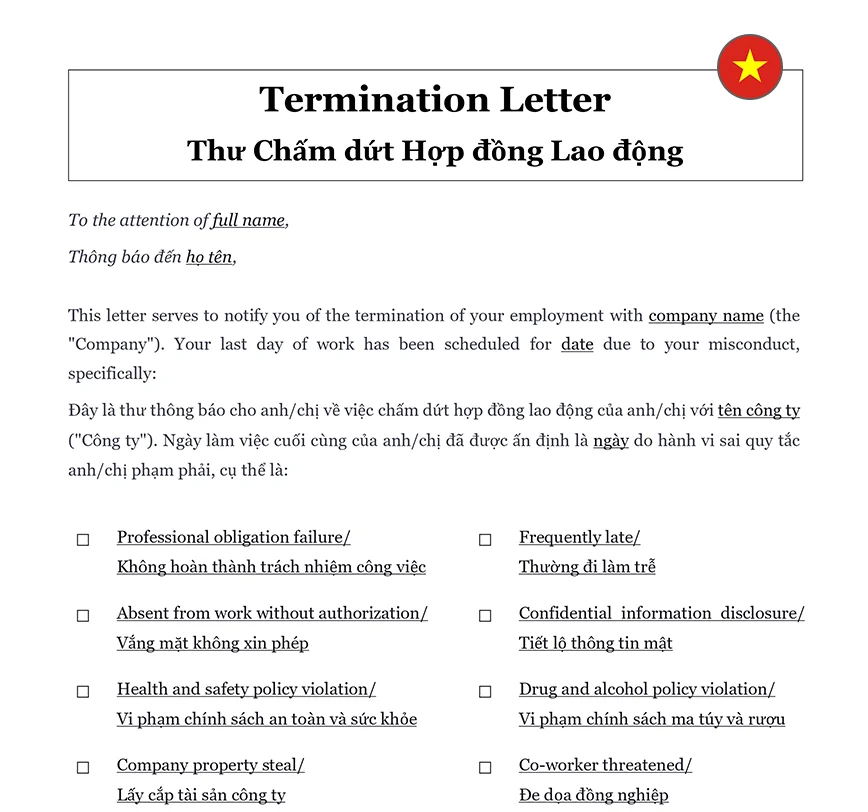Understanding the Legal Grounds to Dismiss an Employee
In Vietnam, the grounds to legally dismiss an employee are specified under the Labor Code 2019. It’s crucial to align your reasons for dismissal with these legal grounds to avoid any potential disputes or legal challenges.
1. Serious Breach of Duties: If an employee commits a serious violation of company policies or engages in misconduct, such as theft or fraud, this can be a valid reason for dismissal. It is essential to document these breaches thoroughly and ensure that they are serious enough to warrant termination. The process should include a detailed investigation and documentation of the employee’s actions.
- Remarks:
Read Handling Employee Misconduct: Legal Guidelines for addressing issues before dismissal.
2. Incapacity: Employees who are unable to perform their job duties due to long-term illness or disability may be subject to dismissal if they are unable to fulfill their job requirements. The employer must provide medical evidence and follow proper procedures to ensure that all options, such as reasonable accommodations, have been exhausted.
ℹ️ For documenting incapacity, use our Employee Performance Evaluation Template to assess and record the employee’s performance issues.
3. Economic Necessity: Organizational restructuring, downsizing, or economic challenges may necessitate the dismissal of employees. This reason must be supported by clear evidence of the business’s financial difficulties or restructuring plans. It is essential to follow legal requirements regarding redundancy and provide appropriate notice and compensation.
4. Contract Expiry: Fixed-term contracts automatically end when their term expires. If the contract is not renewed, the dismissal is generally considered lawful. However, it is important to adhere to the notice period requirements as specified in the employment contract and the Labor Code.
ℹ️ For a thorough understanding of your employment contract, which outlines the terms and conditions relevant to dismissal, refer to our Employment Contract Template. This template helps ensure that all contractual obligations are met.
Steps to Legally Dismiss an Employee
To ensure a legal and smooth dismissal process, follow these detailed steps:
1. Review the Employment Contract
Start by reviewing the employment contract to confirm the grounds for dismissal and ensure that you comply with the terms agreed upon. This includes understanding the notice period, any clauses related to termination, and the employee’s rights.
2. Document the Issues
Compile comprehensive documentation of the employee’s performance issues or misconduct. This should include performance reviews, disciplinary actions taken, and any relevant communications. Thorough documentation helps support your decision and provides evidence if challenged.
3. Provide a Notice Period
Adhere to the notice period requirements specified in the employment contract or the Labor Code. The notice period allows the employee time to prepare for their departure and ensures compliance with legal requirements.
4. Issue an Employment Termination Letter
Draft and deliver a formal Employment Termination Letter to the employee. This letter should clearly state the reasons for dismissal, the effective date, and any details regarding severance pay or compensation. Providing a written notice helps to formalize the process and avoid misunderstandings.
Explore Legal Guide to Terminating Probationary Employees for specific termination guidance.
Crafting an Employment Termination Letter to Dismiss an Employee
An Employment Termination Letter is a vital document in the dismissal process. It serves as formal notification and outlines key details related to the termination. Here’s what should be included:
| ➤ Employee Information: Full name, job title, and employee identification number. |
| ➤ Reason for Dismissal: A clear and detailed explanation of the reasons for termination. |
| ➤ Termination Date: The exact date on which the employment will officially end. |
| ➤ Notice Period: Information about the notice period given or required, including dates. |
| ➤ Severance Pay: Details about severance pay or other compensation, if applicable. |
| ➤ Return of Property: Instructions for the return of any company property or assets. |











